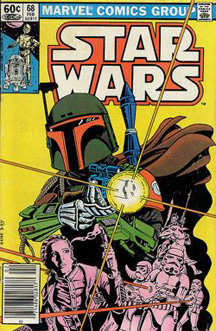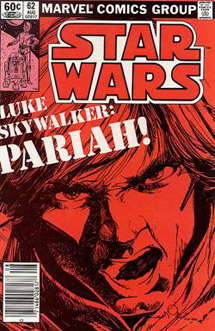Part of the fun of the Marvel comics — and the whole EU, really — is seeing the Kenner action figures come to life. But the best non-main character from the Marvel run, by far, was a new invention, X-wing pilot Shira Brie, and she wasn’t cast in plastic until nearly three decades after her first appearance.
Although she had been in the background as far back as issue 55, Shira’s story arc takes center stage in 60-63 (“Shira’s Story,” “Screams in the Void,” “Pariah!” and “The Mind Spider”). Writer David Michelinie’s work here is better than any previous Marvel arc, although on this re-reading, I wished for more understanding of both Luke’s and Shira’s point of view on their relationship. Clearly, she’s flirting with him, and clearly he’s into it. But when Luke learns that Shira is Darth Vader’s personal spy, it raises the questions: Did Shira actually kind of like Luke? And how hurt is he by her betrayal?
In “Pariah!,” Luke is angry and on a one-track mission to expose Shira and clear his name; it’s very similar to what Ahsoka goes through at the end of Season 5 of “The Clone Wars.” Ahsoka and Luke are hurt by their treatment by colleagues, but they don’t have time to dwell on it. The similarity of the yarns doesn’t continue to the end, though: Ahsoka bitterly leaves the Jedi Order, while Luke is thrilled to be reinstated by the Alliance military. If you ask me, he had plenty of reason to hold a grudge. It’s nice to see that Lando, Chewie and Leia never doubt Luke, but it’s a shame that Chewie is the only one who openly stands with him.
Perhaps when Shira returns as Lumiya, dark lady of the Sith (who also now is an action figure), we’ll learn if there was much actual substance to her feelings for Luke, and vice versa. Or maybe Lumiya’s appearance in “The Legacy of the Force” novels touches on that. I honestly can’t remember. For now, though, it’s a cliffhanger, and it marks the end of Michelinie’s contribution to the character.
Another intriguing question about the Shira arc: Was Timothy Zahn inspired by Shira to create Mara Jade? She’s also a redhead with some connection to the Force who spies for a dark sider (the Emperor), and who ends up romantically linked to Luke.

Before he bows out as the regular scribe, Michelinie launches the “Hunt for Han Solo” arc in issues 68-69 (“The Search Begins” and “Death in the City of Bone”). It’s awesome to see Dengar go from action figure to part of the action. (Truly, those six bounty hunters just stand there in “Empire” like action figures waiting to be played with, don’t they?) And it’s nice to see him called “Dengar” instead of “Zuckuss” (or “Zuckass”) for the first time. Here, we get the first of three characterizations of Dengar: He’s a cyborg (Michelinie gives us the word “cyborg” but no further explanation). “Tales of the Bounty Hunters” would deliver the best Dengar yarn, explaining that he had emotions removed from his brain by Imperial scientists. And “The Clone Wars” then portrayed him as part of Boba Fett’s gang long before the “Tales” story did.

Perhaps Dengar’s story has been smoothed over by ret-conners. And certainly, “mistakes” such as spelling Mandalore’s capital “Kedalbe” instead of “Keldabe” aren’t Michelinie’s fault. But there’s no escaping this gaffe in “The Search Begins”: In a double-page spread, Fenn Shysa tells Leia that he, Tobbi Dala and Boba Fett fought for the Emperor in the Clone Wars, and that Leia was one of their targets. Whoopsie! While Michelinie couldn’t have known Boba Fett’s official backstory, even at this stage of George Lucas’ unfolding of the saga, he should have known that Leia was not old enough to be around during the Clone Wars.
The other issues in this batch are hardly worth mentioning. Well, perhaps “Serphidian Eyes” (64) deserves mention for being the worst issue since the Roy Thomas run. The plot is as standard as they come: Luke and two other X-wing pilots venture to a planet where the king is in league with the Empire and the citizenry is oppressed. Luke jousts on horseback, the reptile king desires to eat the female X-wing pilot, and basically the reader is just glad when it’s over.
“Golrath Never Forgets” (65) is better, albeit ridiculous — the stone walls of the Rebels’ previous base are natural recording devices, so our heroes must destroy it before the Empire gets there. “The Darker” (67) is pretty bad, but it has an ambitious idea: Chewie and (an unusually brave) C-3PO follow R2-D2 into a cavern on Arbra filled with dark-side energy. “The Water Bandits” (66) is one of those “Quantum Leap”-style stories where one of our heroes (Luke, in this case) gets stranded on a random planet, helps the good guys defeat the bad guys, and flirts with a romance that can’t have a future.
“Shadeshine,” the second Marvel annual — told mostly in flashback — is also in the “Quantum Leap” vein, with Han in the lead role. It also reminds me of the amusing “Firefly” episode “Jaynestown,” where Jayne accidentally becomes a hero to an oppressed people. Granted, Han’s not as self-centered as Jayne. But it does seem like he helps the people around him (in this case, a beautiful woman, natch) for somewhat personal reasons, while being slow on the uptake of the wider political implications.
Overall, Michelinie’s run ranks up there with Archie Goodwin’s. Michelinie invented the best new character (Shira) and the best new planet (Arbra), but Goodwin was more consistent from issue to issue. Both had a good grasp of the heroes and the general “Star Wars” feel, but Michelinie was more prone to weird misfires. Quite possibly, Michelinie’s work prompted both the 1990s backlash against the Marvel comics (Kevin J. Anderson snubbed everything from Marvel in the “Star Wars Encyclopedia”), and the 2000s renewed appreciation for them (Lumiya appeared in “Legacy of the Force”).
By an oh-so-slight margin, I prefer Goodwin’s run. Still, Michelinie hands off the baton nicely to the third and final long-term Marvel writer, Mary Jo Duffy, by getting the search for Han started. How does she rank compared to her forbearers? We’ll begin to explore that question in the next post.
Comments
![]() That was something I never thought about, Timothy Zahn really could have created Mara Jade inspired by Shira.
That was something I never thought about, Timothy Zahn really could have created Mara Jade inspired by Shira.
Although I like Michelinie stories more, I have to say he really let his work unfinished. Shira, Arbra and even the search for Han were all storylines left open. Goodwing, for another hand, had concluded everything he began. Most of his creations like Valance, the Tagges, all had a proper ending, he even got to explain how the rebellion established itself on Hoth in the comic strips.# Posted By Eric | 8/25/13 6:21 PM
![]() I’m really noticing the unfinished nature of Michelinie’s work now that I get into the Mary Jo Duffy run. No explanation of the departure from Arbra yet. I know the Shira arc will be picked up later at least.# Posted By John Hansen | 8/26/13 11:56 PM
I’m really noticing the unfinished nature of Michelinie’s work now that I get into the Mary Jo Duffy run. No explanation of the departure from Arbra yet. I know the Shira arc will be picked up later at least.# Posted By John Hansen | 8/26/13 11:56 PM

